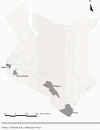The economic costs of malaria in four Kenyan districts: do household costs differ by disease endemicity?
- PMID: 20515508
- PMCID: PMC2890678
- DOI: 10.1186/1475-2875-9-149
The economic costs of malaria in four Kenyan districts: do household costs differ by disease endemicity?
Abstract
Background: Malaria inflicts significant costs on households and on the economy of malaria endemic countries. There is also evidence that the economic burden is higher among the poorest in a population, and that cost burdens differ significantly between wet and dry seasons. What is not clear is whether, and how, the economic burden of malaria differs by disease endemicity. The need to account for geographical and epidemiological differences in the estimation of the social and economic burden of malaria is well recognized, but there is limited data, if any, to support this argument. This study sought to contribute towards filling this gap by comparing malaria cost burdens in four Kenyan districts of different endemicity.
Methods: A cross-sectional household survey was conducted during the peak malaria transmission season in the poorest areas in four Kenyan districts with differing malaria transmission patterns (n = 179 households in Bondo; 205 Gucha; 184 Kwale; 141 Makueni).
Findings: There were significant differences in duration of fever, perception of fever severity and cost burdens. Fever episodes among adults and children over five years in Gucha and Makueni districts (highland endemic and low acute transmission districts respectively) lasted significantly longer than episodes reported in Bondo and Kwale districts (high perennial transmission and seasonal, intense transmission, respectively). Perceptions of illness severity also differed between districts: fevers reported among older children and adults in Gucha and Makueni districts were reported as severe compared to those reported in the other districts. Indirect and total costs differed significantly between districts but differences in direct costs were not significant. Total household costs were highest in Makueni (US$ 19.6 per month) and lowest in Bondo (US$ 9.2 per month).
Conclusions: Cost burdens are the product of complex relationships between social, economic and epidemiological factors. The cost data presented in this study reflect transmission patterns in the four districts, suggesting that a relationship between costs burdens and the nature of transmission might exist, and that the same warrants more attention from researchers and policy makers.
Figures
Similar articles
-
The cost of uncomplicated childhood fevers to Kenyan households: implications for reaching international access targets.BMC Public Health. 2006 Dec 29;6:314. doi: 10.1186/1471-2458-6-314. BMC Public Health. 2006. PMID: 17196105 Free PMC article.
-
The economic burden and catastrophic health expenditures among children with sickle cell anaemia on households in malaria-endemic areas: insights from Uganda and Malawi.BMC Public Health. 2025 Jun 4;25(1):2070. doi: 10.1186/s12889-025-23209-x. BMC Public Health. 2025. PMID: 40468209 Free PMC article.
-
Use of over-the-counter malaria medicines in children and adults in three districts in Kenya: implications for private medicine retailer interventions.Malar J. 2007 May 10;6:57. doi: 10.1186/1475-2875-6-57. Malar J. 2007. PMID: 17493270 Free PMC article.
-
Cost of treating severe malaria in children in Africa: a systematic literature review.Malar J. 2024 Nov 9;23(1):334. doi: 10.1186/s12936-024-05173-w. Malar J. 2024. PMID: 39522014 Free PMC article.
-
The economic impact of malaria in Africa: a critical review of the evidence.Health Policy. 2003 Jan;63(1):17-36. doi: 10.1016/s0168-8510(02)00036-2. Health Policy. 2003. PMID: 12468115 Review.
Cited by
-
Vulnerability of farming communities to malaria in the Bole district, Ghana.Parasite Epidemiol Control. 2018 Aug 2;3(4):e00073. doi: 10.1016/j.parepi.2018.e00073. eCollection 2018 Nov. Parasite Epidemiol Control. 2018. PMID: 30234178 Free PMC article.
-
The economic burden of meningitis to households in Kassena-Nankana district of Northern Ghana.PLoS One. 2013 Nov 21;8(11):e79880. doi: 10.1371/journal.pone.0079880. eCollection 2013. PLoS One. 2013. PMID: 24278203 Free PMC article.
-
The economic burden of malaria: a systematic review.Malar J. 2022 Oct 5;21(1):283. doi: 10.1186/s12936-022-04303-6. Malar J. 2022. PMID: 36199078 Free PMC article.
-
Socioeconomic health inequality in malaria indicators in rural western Kenya: evidence from a household malaria survey on burden and care-seeking behaviour.Malar J. 2018 Apr 16;17(1):166. doi: 10.1186/s12936-018-2319-0. Malar J. 2018. PMID: 29661245 Free PMC article.
-
What are fair study benefits in international health research? Consulting community members in Kenya.PLoS One. 2014 Dec 3;9(12):e113112. doi: 10.1371/journal.pone.0113112. eCollection 2014. PLoS One. 2014. PMID: 25470596 Free PMC article.
References
-
- Ettling M, McFarland DA, Schultz LJ, Chitsulo L. Economic impact of malaria in Malawian households. Trop Med Parasitol. 1994;45:74–79. - PubMed
-
- Somi MF, Butler JR, Vahid F, Njau J, Kachur SP, Abdulla S. Is there evidence for dual causation between malaria and socioeconomic status? Findings from rural Tanzania. Am J Trop Med Hyg. 2007;77:1020–1027. - PubMed
-
- Somi MF, Butler JR, Vahid F, Njau JD, Kachur SP, Abdulla S. Economic burden of malaria in rural Tanzania: variations by socioeconomic status and season. Trop Med Int Health. 2007;12:1139–1147. - PubMed
-
- Uzochukwu BS, Onwujekwe OE. Socio-economic differences and health seeking behaviour for the diagnosis and treatment of malaria: a case study of four local government areas operating the Bamako initiative programme in south-east Nigeria. Int J Equity Health. 2004;3:6. doi: 10.1186/1475-9276-3-6. - DOI - PMC - PubMed
Publication types
MeSH terms
Substances
LinkOut - more resources
Full Text Sources
Medical
Miscellaneous



